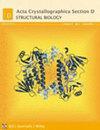揭开龙虾壳着色机制的结构化学。
IF 2.2
4区 生物学
Acta Crystallographica Section D: Biological Crystallography
Pub Date : 2003-12-01
DOI:10.1107/S0907444905019621
引用次数: 64
摘要
应用生物化学、生物晶体学、光谱学、溶液x射线散射和显微镜等方法研究了龙虾壳着色的分子基础。这篇文章提出了一个进展的审查,集中在最近的结果,但在超过50年的工作背景下。龙虾的蓝色外壳是由一种多分子胡萝卜素蛋白-甲壳蛋白提供的。该复合物由5个不同的亚基组成,每个亚基结合类胡萝卜素虾青素(AXT)。结构研究的突破来自β -甲壳青素(A1和A3蛋白亚基与两个共享结合的虾青素)结构的确定。这是解决了分子替换,以apocrustacyanin A1为搜索基序。基于这两个“终点”蛋白结构,即与β -甲壳青素中两种虾青素相关的apocrustacyanin A1和A1,现在已经通过线性插值计算出了分子膜。这部电影突出的结构变化迫使类胡萝卜素络合。相比之下,蛋白质结合位点在结合区域内保持相对不变,但在较远的表面环区发生了较大的构象变化。本文认为,该环可能是重要的络合的AXT,并有助于光谱性质。本文还介绍了在5 A分辨率下首次观察到完整的“α -甲壳蛋白”复合物的单晶衍射,该复合物由16个蛋白质亚基和16个结合的AXT分子(即8个β -甲壳蛋白)组成。结晶条件的优化仍然是必要的,因为这些图案显示出多晶特征,然而,现在已经实现了10a分辨率的单晶衍射。提供新的SRS MPW 10和SRS MPW 14光束线机器人系统将极大地协助测量正在进行的许多α -甲壳蛋白结晶试验。本文还介绍了新的溶液x射线散射(SXS)测量方法。β -甲壳蛋白SXS数据显示了holo配合物如何符合SXS曲线,而来自晶体数据的apocrustacyanin A1同型二聚体自然不符合SXS曲线。从α -甲壳蛋白的散射剖面形状进行重构。基于四重对称约束的最合理的超微结构被发现是一个有四条腿的凳子。将后者与已发表的电子显微照片进行比较。现在,为了将AXT的完整的150 nm的深色移与完整的分子结构联系起来,研究了α -甲壳蛋白的详细晶体结构,而β -甲壳蛋白二聚体仅实现了100 nm的深色移。由于这项工作,稀有龙虾的着色引起了人们的注意,并在附录中进行了讨论。本文章由计算机程序翻译,如有差异,请以英文原文为准。
Unravelling the structural chemistry of the colouration mechanism in lobster shell.
Biochemistry, biological crystallography, spectroscopy, solution X-ray scattering and microscopy have been applied to study the molecular basis of the colouration in lobster shell. This article presents a review of progress concentrating on recent results but set in the context of more than 50 years of work. The blue colouration of the carapace of the lobster Homarus gammarus is provided by a multimolecular carotenoprotein, alpha-crustacyanin. The complex is a 16-mer of five different subunits each binding the carotenoid, astaxanthin (AXT). A breakthrough in the structural studies came from the determination of the structure of beta-crustacyanin (protein subunits A1 with A3 with two shared bound astaxanthins). This was solved by molecular replacement using apocrustacyanin A1 as the search motif. A molecular movie has now been calculated by linear interpolation based on these two 'end-point' protein structures, i.e. apocrustacyanin A1 and A1 associated with the two astaxanthins in beta-crustacyanin, and is presented with this paper. This movie highlights the structural changes forced upon the carotenoid on complexation. In contrast, the protein-binding site remains relatively unchanged in the binding region, but there is a large conformational change occurring in a more remote surface-loop region. It is suggested here that this loop could be important in complexation of AXT and contributes to the spectral properties. Also presented here is the first observation of single-crystal diffraction of the full 'alpha-crustacyanin' complex comprising 16 protein subunits and 16 bound AXT molecules (i.e eight beta-crustacyanins) at 5 A resolution. Optimization of crystallization conditions is still necessary as these patterns show multiple crystallite character, however, 10 A resolution single-crystal diffraction has now been achieved. Provision of the new SRS MPW 10 and SRS MPW 14 beamline robotic systems will greatly assist in the surveying of the many alpha-crustacyanin crystallization trials that are being made. New solution X-ray scattering (SXS) measurements of beta- and alpha-crustacyanin are also presented. The beta-crustacyanin SXS data serve to show how the holo complex fits the SXS curve, whereas the apocrustacyanin A1 homodimer from the crystal data naturally does not. Reconstructions of alpha-crustacyanin were accomplished from its scattering-profile shape. The most plausible ultrastructure, based on a fourfold symmetry constraint, was found to be a stool with four legs. The latter is compared with published electron micrographs. A detailed crystal structure of alpha-crustacyanin is now sought in order to relate the full 150 nm bathochromic shift of AXT to that complete molecular structure, compared with the 100 nm achieved by the beta-crustacyanin protein dimer alone. Rare lobster colourations have been brought to attention as a result of this work and are discussed in an appendix.
求助全文
通过发布文献求助,成功后即可免费获取论文全文。
去求助
来源期刊
自引率
13.60%
发文量
0
审稿时长
3 months
期刊介绍:
Acta Crystallographica Section D welcomes the submission of articles covering any aspect of structural biology, with a particular emphasis on the structures of biological macromolecules or the methods used to determine them.
Reports on new structures of biological importance may address the smallest macromolecules to the largest complex molecular machines. These structures may have been determined using any structural biology technique including crystallography, NMR, cryoEM and/or other techniques. The key criterion is that such articles must present significant new insights into biological, chemical or medical sciences. The inclusion of complementary data that support the conclusions drawn from the structural studies (such as binding studies, mass spectrometry, enzyme assays, or analysis of mutants or other modified forms of biological macromolecule) is encouraged.
Methods articles may include new approaches to any aspect of biological structure determination or structure analysis but will only be accepted where they focus on new methods that are demonstrated to be of general applicability and importance to structural biology. Articles describing particularly difficult problems in structural biology are also welcomed, if the analysis would provide useful insights to others facing similar problems.

 求助内容:
求助内容: 应助结果提醒方式:
应助结果提醒方式:


